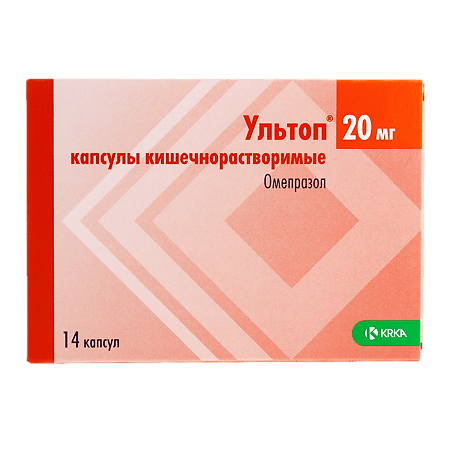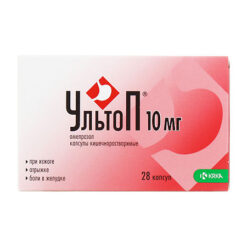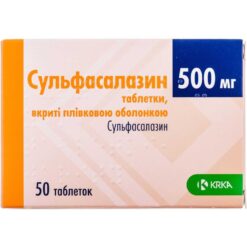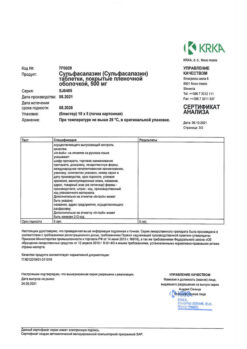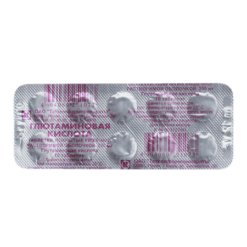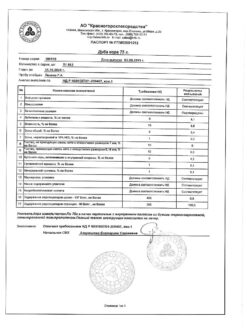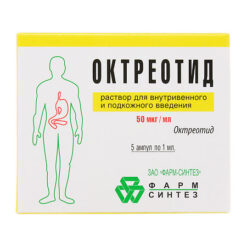No products in the cart.
Ultop, 20 mg 14 pcs
€3.60 €3.00
EAN: 4607055136621
SKU: 206841
Categories: Medicine, Stomach, intestines, liver, Ulcer and gastritis
Description
Pharmacodynamics
Inhibits the enzyme H+ K+ ATPase (“proton pump”) in the parietal cells of the stomach and thereby blocks the final stage of hydrochloric acid synthesis. This leads to a decrease in basal and stimulated secretion, regardless of the nature of the stimulus. The drug is prodrug and is activated in the acid environment of the secretory tubules of the parietal cells. After a single oral dose, the action of omeprazole occurs within the first hour and continues for 24 hours, the maximum effect being reached after 2 hours.
After discontinuation of the drug, secretory activity is fully restored after 3-5 days. Basal gastric secretion decreases to 94% after 40 mg of omeprazole. Gastric acidity within 24 hours is reduced by 80 to 97% with 20 mg omeprazole and by 92 to 94% with 40 mg. Inhibition of 50% of maximum secretion lasts for 24 hours.
Pharmacokinetics
Omeprazole is rapidly absorbed from the gastrointestinal tract, reaching maximum plasma concentration in 0.5-1 hours. Bioavailability is 30-40%. Bioavailability is slightly increased in elderly and patients with impaired liver function, and to a large extent in patients with chronic hepatic failure (can reach 100%). Binding to plasma proteins is about 90% to 95%. Omeprazole is almost completely metabolized in the liver with the formation of 6 metabolites (hydroxyomeprazole, sulfide and sulfone derivatives, etc.), pharmacologically inactive. It is an inhibitor of the CYP2C19 enzyme system. The elimination half-life is 0.5-1 hour. Excretion by the kidneys (70-80%) and with bile (20-30%). In chronic renal failure excretion decreases in proportion to the decrease in creatinine clearance. In elderly patients excretion decreases. In patients with hepatic insufficiency half-life is 2 – 3 hours.
Total clearance is 500 – 600 ml/min.
Indications
Indications
Peptic ulcer of the stomach and duodenum (in the acute phase and anti-relapse treatment), incl. associated with Helicobacter pylori (as part of combination therapy);
Gastroesophageal reflux disease (GERD), including reflux esophagitis and non-erosive forms of reflux disease (NERD);
Erosive and ulcerative lesions of the stomach and duodenum associated with the use of non-steroidal anti-inflammatory drugs (NSAIDs), stress ulcers;
Zollinger-Ellison syndrome and other pathological conditions associated with increased gastric secretion.
Pharmacological effect
Pharmacological effect
Pharmacodynamics
Inhibits the enzyme H+ K+ ATPase (“proton pump”) in the parietal cells of the stomach and thereby blocks the final stage of hydrochloric acid synthesis. This leads to a decrease in the level of basal and stimulated secretion, regardless of the nature of the stimulus. The drug is a prodrug and is activated in the acidic environment of the secretory tubules of parietal cells. After a single dose of the drug orally, the effect of omeprazole occurs within the first hour and continues for 24 hours, the maximum effect is achieved after 2 hours.
After stopping the drug, secretory activity is completely restored after 3-5 days. Basal gastric secretion decreases to 94% after taking 40 mg of omeprazole. The acidity of gastric juice within 24 hours is reduced by 80 – 97% when taking 20 mg of omeprazole and by 92 – 94% when taking 40 mg. Inhibition of 50% of maximum secretion lasts 24 hours.
Pharmacokinetics
Omeprazole is rapidly absorbed from the gastrointestinal tract, the maximum concentration in plasma is reached after 0.5-1 hour. Bioavailability is 30-40%. Bioavailability increases slightly in the elderly and patients with impaired liver function, and to a significant extent in patients with chronic liver failure (can reach 100%). Communication with plasma proteins is about 90% – 95%. Omeprazole is almost completely metabolized in the liver with the formation of 6 metabolites (hydroxyomeprazole, sulfide and sulfone derivatives, etc.), which are pharmacologically inactive. It is an inhibitor of the CYP2C19 enzyme system. The half-life is 0.5-1 hour. Excretion by the kidneys (70-80%) and bile (20-30%). In chronic renal failure, excretion decreases in proportion to the decrease in creatinine clearance. In elderly patients, excretion decreases. In case of liver failure, the half-life is 2 – 3 hours.
Total clearance – 500 – 600 ml/min.
Special instructions
Special instructions
Before starting therapy, it is necessary to exclude the presence of a malignant process (especially with a stomach ulcer), since treatment, masking symptoms, can delay the correct diagnosis.
For elderly patients, no dose adjustment is required. The bioavailability of omeprazole is increased in patients with liver cirrhosis, but no increase in toxicity was observed. The daily dose should not exceed 20 mg.
No dose adjustment is required for patients with kidney disease. Dialysis in patients with chronic kidney disease does not affect the pharmacokinetic properties of omeprazole.
Effect on the ability to drive a car and other mechanisms
In normal dosages, the drug does not affect the speed of psychomotor reactions and concentration.
Active ingredient
Active ingredient
Omeprazole
Composition
Composition
1 capsule contains:
Active substance:
Omeprazole 20 mg.
Excipients:
Granulated sugar (sucrose, starch syrup);
Hyprolose;
Magnesium hydroxycarbonate;
Sucrose;
Corn starch;
Sodium lauryl sulfate.
Pregnancy
Pregnancy
The safety of use during pregnancy and lactation and breastfeeding has not been studied. Therefore, it is not recommended to prescribe the drug during pregnancy. If it is necessary to prescribe the drug during lactation, breastfeeding should be stopped.
Contraindications
Contraindications
Hypersensitivity to omeprazole or other components of the drug;
Children’s age (efficacy and safety in children has not been proven);
Pregnancy;
Lactation period.
With caution:
Renal and/or liver failure;
Hereditary fructose intolerance;
Glucose and/or galactose malabsorption syndrome or sucrose/isomaltose deficiency.
Side Effects
Side Effects
From the digestive system: diarrhea or constipation, nausea, vomiting, flatulence, abdominal pain, dry mouth, taste disturbances, stomatitis, transient increase in the activity of liver enzymes in plasma; in patients with previous severe liver disease – hepatitis (including jaundice), impaired liver function.
From the nervous system: headache, dizziness, agitation, drowsiness, insomnia, paresthesia, depression, hallucinations; in patients with severe concomitant somatic diseases, patients with previous severe liver disease – encephalopathy.
From the cardiovascular system: angina pectoris, tachycardia, bradycardia, palpitations, increased blood pressure, vasculitis, peripheral edema.
From the genitourinary system: interstitial nephritis, urinary tract infections, microscopic pyuria, proteinuria, hematuria, glucosuria, increased serum creatinine concentration, gynecomastia, testicular pain.
From the musculoskeletal system: muscle weakness, myalgia, arthralgia, bone pain, muscle cramps.
From the hematopoietic system: pancytopenia, agranulocytosis, anemia, neutropenia, thrombocytopenia, leukocytosis, leukopenia.
From the skin: petechiae, skin itching, skin rash; in some cases – photosensitivity, exudative erythema multiforme, hair loss, alopecia, dry skin, epidermal toxic necrolysis, Stevens-Johnson syndrome.
From the respiratory system: sore throat, cough, profuse nosebleeds.
From the senses: ringing in the ears, mild visual and hearing impairment.
Allergic reactions: urticaria, angioedema, bronchospasm, interstitial nephritis, anaphylactic shock, fever.
Laboratory indicators: hypoglycemia, hyponatremia.
Other: back pain, increased sweating; rarely – the formation of gastric glandular cysts during long-term treatment (a consequence of inhibition of hydrochloric acid secretion, is benign, reversible), general fatigue, general weakness, weight gain, fever.
Interaction
Interaction
Long-term use of omeprazole at a dose of 20 mg 1 time / day in combination with caffeine, theophylline, piroxicam, diclofenac, naproxen, metoprolol, propranolol, ethanol, cyclosporine, lidocaine, quinidine and estradiol did not lead to a change in their plasma concentrations.
There was no interaction between omeprazole and concomitantly taken antacids.
Omeprazole may reduce the absorption of ampicillin esters, iron salts, itraconazole and ketoconazole (because omeprazole increases gastric pH).
Being an inhibitor of cytochrome P450, omeprazole can increase the concentration and reduce the excretion of diazepam, indirect anticoagulants, phenytoin, which in some cases may require a reduction in the doses of these drugs.
When taken simultaneously, the absorption of omeprazole and clarithromycin is enhanced.
Overdose
Overdose
Symptoms: abdominal pain, drowsiness, headache, dizziness, dry mouth, tachycardia, arrhythmia, blurred vision, agitation, confusion, increased sweating, nausea; in rare cases; convulsions, shortness of breath, hypothermia.
Treatment is symptomatic. There is no specific antidote. Hemodialysis is ineffective.
Storage conditions
Storage conditions
In a dry place, at temperatures below 25 °C.
Shelf life
Shelf life
3 years.
Manufacturer
Manufacturer
KRKA-RUS, Russia
Additional information
| Shelf life | 3 years. |
|---|---|
| Conditions of storage | In a dry place, at a temperature below 25 °C. |
| Manufacturer | KRKA dd Novo mesto, Slovenia |
| Medication form | enteric capsules |
| Brand | KRKA dd Novo mesto |
Other forms…
Related products
Buy Ultop, 20 mg 14 pcs with delivery to USA, UK, Europe and over 120 other countries.

